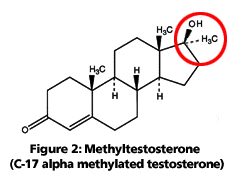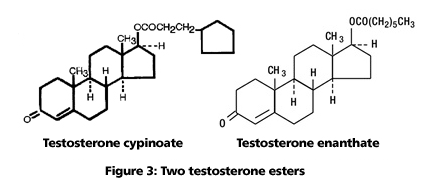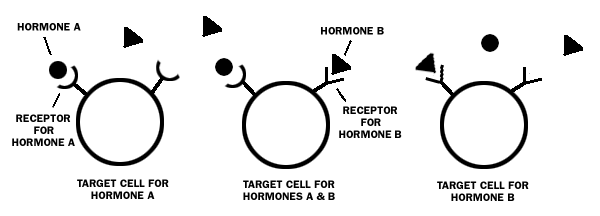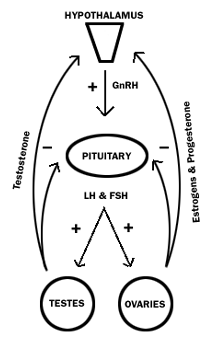



FTM's Research and Information Here
DISCLAIMER
The information contained herein is to be used for educational purposes only. The author is not a medical professional, and this information should not be considered medical advice. This information should NOT be used to replace consultation with or treatment by a trained medical professional. The listing of a medication herein does not imply endorsement by the author.
What are "bioidentical hormones?"
A "bioidentical hormone" refers to a substance that has the exact same chemical structure as a hormone that is naturally produced in the body. For example, the testosterone that is naturally produced in the human body has the chemical formula C19H28O2 and the following chemical structure:

In order for prescription testosterone to be considered "bioidentical," its chemical structure should match the above structure identically. (Bear in mind that even though the illustration shown above looks flat, molecules in real life are three dimensional. Even minor changes in a chemical structure can change the overall shape of a molecule, and thus can affect its ability to bond with other molecules and perform certain tasks in the body.)
What are "natural" versus "synthetic" hormones?
When reading the latest buzzwords about hormone therapy, the use of the terms "natural" and "synthetic" can be very confusing. This is because the word "bioidentical" is often equated to "natural," while being contrasted with "synthetic" and "man-made." These generalizations can be a bit misleading; we'll examine them more closely in order to better understand the differences between different testosterone treatments.
First, the term "natural" is often used to mean something that is found in nature, or something that is not man-made. In the case of testosterone, the "natural" form of the hormone is produced in the glands of the body; its chemical structure is shown above in Figure 1.
Next, let's recall that "bioidentical" testosterone is defined as having the exact same chemical structure as the "natural" testosterone that is created by the body. In this sense, "bioidentical" testosterone matches "natural" testosterone on the molecular level.
If there is any chemical modification to the testosterone molecule (such as adding a side chain or functional group), it no longer fits under the definition of "bioidentical." This is what is often referred to as a "synthetic" hormone-- a substance that has been modified in chemical structure from how it would occur naturally. An example of a "synthetic" hormone would be methyltestosterone (Figure 2, below), which is the testosterone hormone with an added methyl group (CH3) at the c-17 alpha position of the molecule (modified area shown within the red circle).

As illustrated in the case of methyltestosterone, the word "synthetic" is used to indicate a variation of a hormone created in a laboratory that does not chemically match the hormone as naturally made by the body.
It is important to note at this point that all forms of prescription testosterone-- whether they are "bioidentical" or "synthetic"-- are created in laboratories using chemical means. The vast majority of prescription testosterone (cream, gel, injectable, patch, subcutaneous, etc.) is derived from plant sources such as soybeans and yams. Soybeans and yams are natural substances that are put through a chemical synthesis in a laboratory setting to derive the end product of testosterone. Both bioidentical and non-bioidentical testosterone drugs are synthesized in this manner.
In summary, all testosterone drug preparations are man-made, typically from plant-based sources. "Bioidentical" testosterone exactly matches the chemical structure of "natural" testosterone, but is made in a laboratory just like other non-bioidentical forms of testosterone. Even though all forms of testosterone preparations are synthesized in a laboratory setting, the word "synthetic" is usually used to refer to non-bioidentical forms of testosterone.
Why would a drug company want to modify testosterone in the first place?
There are two main reasons why a drug company might want to modify a naturally-occuring substance such as testosterone. The first is functionality (i.e. so that the substance is able to be used successfully by the body), and the second is patentability and profit. In the specific case of testosterone, most of the modifications that we see are done for the sake of functionality, which is explained further below. Patentability and profit is also briefly addressed at the end of this section.
On the topic of functionality, a specific group of atoms (called a "functional group") may be added to the testosterone molecule in order to help make the hormone "bioavailable" (i.e., able to be absorbed and used by the body). Depending on the method of delivery (taking an injection versus swallowing a pill, for example), this may involve using different functional groups to serve different purposes.
Injectable testosterone modifications
In the case of injectable testosterone, an "ester" functional group is usually added to the testosterone molecule (see Figure 3, below). An "ester" is simply a name for a chemical compound that is formed from a reaction between a carboxylic acid and an alcohol. There are many different ester groups that can be added to testosterone: cypionate, enanthate, acetate, propionate, phenylpropionate, isocaproate, caproate, decanoate, and undecanoate, to name the most common ones.

Ester groups are added to improve the solubility of testosterone in oil, which in turn slows the release of the testosterone from its injection site into the blood stream. Without an added ester group, injectable testosterone would enter the blood stream very quickly, and would have to be administered in small doses daily (or several times a day) in order to maintain acceptable levels of the hormone in the body. Thus, adding an ester group to an injectable allows for a relatively easy dosing regimen, far fewer intramuscular shots, and a slow release of hormone into the system.
As a testosterone ester enters the blood stream, the ester group is cleaved off by "esterase enzymes" in a process known as "hydrolization." Once the ester group has been removed by these enzymes, the testosterone is returned to its "bioidentical" form, thus making it bioavailable and ready to perform its various actions and effects.
Oral testosterone modifications
In the case of oral delivery, modifications have been made to the testosterone molecule to try to combat problems caused by the "first pass effect." Drugs that are taken orally (i.e., swallowed) are absorbed from the gastrointestinal tract and pass via the portal vein into the liver. If bioidentical testosterone is given orally, a very large portion is metabolized during this "first pass" through the liver, and therefore it cannot become bioavailable to do its work in the body.
One of the earliest attempts to address this issue was the development of methyltestosterone (where a methyl group was added at the c-17 alpha position of the testosterone molecule; Figure 2). The use of methylated testosterone did have the result of making oral testosterone more readily bioavailable, but it also was found to be very hard on the liver, and thus caused health problems. Because of this, methyltestosterone is rarely used for hormone therapy today, as safer forms of delivery have become available.
A more recent development in oral testosterone delivery is the use of a capsule form of testosterone undecanoate, a testosterone ester dissolved in oleic acid. Because it is designed to be absorbed through the small intestine into the lymphatic system (thus circumventing the "first pass" through the liver), it poses less burden on the liver than methyltestosterone. Therefore, it is considered a safer oral form of testosterone. (Oral testosterone undecanoate is not available in the United States.)
Patents and profit
The second reason a drug company might try to modify a naturally-occurring substance such as testosterone is for the sake of being able to create a unique formulation that can be patented and sold exclusively by that company for a period of time.
Testosterone is a substance that occurs naturally in the human body. Therefore, a drug company cannot patent the manufacture of simple testosterone in its natural configuration, because they did not invent the chemical formula for that hormone-- they merely copy the blueprint nature has already provided for them. However, if a drug company chemically modifies a hormone's structure in a unique fashion, or develops a new formulation/system for a unique delivery method of a hormone, that company may apply for a patent for that drug. If their newly-created drug is approved by the Food and Drug Administration (FDA) for safety and their patent is accepted, then they may then profit solely from the drug's manufacture for a number of years before other companies can create generic or brand-name equivalents.
While drug companies certainly can profit from modifying testosterone in new ways, or by figuring out new and unique methods for getting the hormone into the system, the fact is that many tried-and-true delivery methods of testosterone have already been developed, and most of these testosterone types can be found in low-cost generic equivalents or compounded forms. Injectable testosterone esters, for example, are available as brand-name products from large pharmaceutical companies, but also as lower-cost generics and in formulas that can be produced by small compounding pharmacies. Testosterone creams, gels, pellets, and buccal systems are also available in generic and/or compounded formulations. In the case of prescription testosterone therapy, both patient and doctor have a number of options from which to choose.
Why do some people prefer bioidentical hormones?
Proponents of bioidentical hormones claim that because such hormones are identical in chemical structure to the hormones produced by the body, our bodies will metabolize them as they designed to do, thereby minimizing negative side effects. While this is certainly a sensible-sounding theory, there has been little study comparing bioidentical hormones to non-bioidentical preparations, and therefore little data is available to make sweeping conclusions about any differences in side effects or results.
It is true that negative side effects to the liver have been shown in the case of orally-administered methyltestosterone (a non-bioidentical testosterone), as described in the previous section. This is why oral methyltestosterone is rarely used for testosterone therapy, as safer alternatives are available.
As for whether bioidentical testosterone preparations are safer, more effective, or show fewer side effects than testosterone ester formulations, there is little data available for comparison. Recall, too, that once a testosterone ester has entered the bloodstream, the ester group is cleaved off of the molecule by an enzyme, returning the testosterone molecule to its free, bioidentical state. The testosterone is then metabolized by the body just as natural testosterone would be metabolized.
Whatever hormone regimen you choose, continue to work with your doctor. He or she will order periodic blood tests and other tests to monitor your hormone levels and overall health. If you and your doctor choose to use a compounding pharmacy to fill your hormone prescription, be sure to choose a reputable pharmacy that utilizes the proper technology and facilities needed to prepare your medication in a safe and appropriate manner.
Which types of testosterone are bioidentical?
It is important to understand that in the United States, testosterone is considered a Schedule III controlled substance, and is not available without a prescription from a doctor. Therefore, if you see internet advertisements for "testosterone" creams, pills, or gels that do not require a prescription, understand that those products do not contain testosterone. Additionally, the buyer should beware of nutritional supplements, or so-called "pro-hormones" and "hormone pre-cursors" that promise to increase testosterone levels. Such products do not contain testosterone, they do not work in the same manner as prescribed testosterone, and they are not tested for safety and effectiveness by the U.S. Food and Drug Administration (FDA).
Once you have been approved by your doctor for testosterone therapy, there are a variety of options for how your doctor can write a prescription. The most common method of testosterone therapy for trans men is intramuscular injection with a syringe. Other delivery methods include transdermal systems via gel, cream, or patch applied to the skin; orally by swallowing tablets or capsules (uncommon in the U.S.); sublingually/buccally by dissolving a tablet under the tongue or against the gums; or by a pellet inserted under the skin.
Transdermal (i.e., medication is absorbed through the skin)
In general, most transdermal forms of prescription testosterone (such as gels, creams, and patches) contain bioidentical testosterone. Because bioidentical testosterone becomes active quickly once absorbed through the skin, it must be applied daily to maintain appropriate levels of testosterone in the body. Depending on the formulation, transdermal preparations might also include additional ingredients to accelerate the absorption of the testosterone through the skin. Some of these ingredients can cause side effects, such as rashes and skin irritation. Transdermal testosterone is available in both brand-name and compounded preparations; a prescription for compounded transdermal testosterone can be tailored by your doctor for your specific dosage requirements.
Sublingual/buccal
Sublingual and buccal testosterone treatments, which are dissolved in the mouth rather than swallowed, are generally made with bioidentical testosterone. Sublingual preparations are dissolved under the tongue; these can be prepared by compounding pharmacies. Buccal testosterone delivery works placing a tablet against the surface of the gums. Buccal testosterone systems are available as name-brand or compounded preparations. Sublingual/buccal delivery is different from oral delivery in that very little of the substance is swallowed, avoiding potential "first pass effect" problems with the liver. Because bioidentical testosterone is absorbed quickly through sublingual/buccal routes, it must be applied more than once a day to maintain appropriate levels of testosterone in the body.
Subcutaneous testosterone pellets are made of bioidentical, crystalline testosterone that is implanted beneath the skin. The pellets are about the size of a grain of rice, and are typically placed in the buttocks or abdomen by a doctor. Because of their crystalline form, the testosterone in subcutaneous pellets is released slowly over a period of weeks or months.
Injectables
As mentioned previously on this page, injectable testosterone is prepared mainly in the form of testosterone esters such as testosterone cypionate or testosterone enanthate. Because a testosterone ester is a modified form of the testosterone molecule, it should not technically be considered a bioidentical form of testosterone. However, when testosterone esters are released into the bloodstream, the ester group is cleaved off by "esterase enzymes" in a process known as "hydrolization." Once the ester group has been removed by these enzymes, the testosterone is returned to its free, bioidentical form, thus making it bioavailable and ready to perform its various actions and effects.
Oral
Bioidentical testosterone is never taken orally since it will be immediately deactivated by the liver due to the "first pass effect." Two non-bioidentical forms of testosterone have been used in testosterone therapy: methyltestosterone and testosterone undecanoate.
As mentioned previously, methyltestosterone is one of the earliest available oral testosterones. Its chemical structure is the hormone testosterone with an added methyl group at the c-17 alpha position of the molecule. The use of oral c-17 alpha methylated testosterone is not recommended due to its potential toxicity to the liver.
Testosterone undecanoate is not a c-17 alpha methylated hormone, it is a testosterone ester. Because it is designed to be absorbed through the small intestine into the lymphatic system (thus circumventing the "first pass" through the liver), it poses less burden on the liver than methyltestosterone. Therefore, it is considered a safer oral form of testosterone. Oral testosterone undecanoate is not available in the United States.
If you are unsure if the prescription testosterone you are using is bioidentical, check the prescription information sheet to read both the chemical formula and chemical structure. This information should be provided to you with the medication.
Hormones and the Body: A Brief Overview
DISCLAIMER
The information contained herein is to be used for educational purposes only. The author is not a medical professional, and this information should not be considered medical advice. This information should NOT be used to replace consultation with or treatment by a trained medical professional. The listing of a medication herein does not imply endorsement by the author.
What is a hormone?
"Hormones" are important chemical messengers in the body that effectively transfer signals and instructions from one set of cells to another.
What is endocrinology?
"Endocrinology" is traditionally defined as the branch of biological science that concerns itself with the actions of hormones and the organs in which hormones are formed. A doctor who specializes in the function of hormones is called an "endocrinologist."
Where do hormones come from and what do they do?
Hormones are secreted (usually into the bloodstream) by a collection of glands inside the body referred to as the "endocrine system." (A "gland" is a group of cells that produces and secretes chemicals into the body.) The major glands that make up the endocrine system include the hypothalamus, the pituitary gland, the thyroid and parathyroids, the adrenals, the pineal body, and the ovaries and testes (the "gonads").
Hormones can also be produced synthetically in a laboratory setting and are prescribed by doctors to treat disease or hormone deficiencies. For example, if a person has had their thyroid gland removed, a doctor may prescribe synthetic thyroid hormones to replace those that the person's body can no longer produce.
Over fifty different hormones have been identified in the bodies of humans, and more are still being discovered. Hormones influence and regulate practically every cell, tissue, organ, and function of our bodies, including growth, development, metabolism, maintenance/balance of our internal environment ("homeostasis"), and sexual and reproductive function.
How do hormones cause their effects?
Most hormones circulate via the blood, thus coming into contact with all kinds of cells throughout the body. However, a given hormone usually affects only a limited number of cells, which are called "target cells" for that hormone. A target cell responds to a hormone because it bears "receptors" for that hormone. Hormones, like all molecules, have a specific molecular shape, and thus will fit into certain receptors but not others (see illustration below).

When it binds to the receptor site of a target cell, a molecule might act as an "agonist" or as an "antagonist" (or some combination of the two).
"Agonists" are molecules that bind to the receptor site of a target cell and produce biological effects as a result. For example, when the hormone "testosterone" is secreted into the blood and binds to a target cell's receptor site, biological effects from that binding will result in producing a specific physical change (such as the stimulation of a hair follicle to produce a whisker on the chin). Testosterone is an example of an agonist in this case.
Bear in mind that in many cases, more than one distinct hormone can bind to the same receptor. For a given receptor, different agonists can have dramatically different potencies.
"Antagonists" are molecules that bind to the receptor site of a target cell while at the same time failing to trigger the biochemical results of the agonist. Antagonist molecules may compete with an agonist for receptor sites, thus preventing or blocking the binding of an agonist. For this reason, antagonist compounds are often used as drugs.
An example of an antagonist is the drug Tamoxifen, which serves as an estrogen-receptor antagonist in breast tissue (it is sometimes called an "anti-estrogen" in medical literature). Tamoxifen is used in the treatment of breast cancer. It binds to estrogen target cell receptors in the breasts and blocks the ability of estrogen to produce its biologic effects--one of which is the feeding of the cancer itself.
Interestingly, while Tamoxifen acts as an estrogen antagonist in breast tissue, it also acts as an estrogen agonist in the bones. That is, Tamoxifen produces a mixture of antagonist/agonist reactions, blocking the actions of estrogen in the breasts, while also producing the (positive) biologic effects of estrogen in the bones.
How are hormones regulated in the body?
The production of hormones in the body is almost always regulated by a delicate set of feedback relationships, or "feedback loops." Most (but not all) hormone secretion is governed by "negative" feedback loops, wherein the amount of a substance in a system regulates its own concentration. When concentration of a hormone rises to above desired levels, a series of steps is taken within the system to cause the concentration to fall. Conversely, steps are taken to increase concentration when the level is too low.
Imagine a home-heating system as an example of a simple negative feedback loop. When the temperature of a room rises above the set point of a thermostat, the thermostat is then triggered and shuts off the furnace (the heat feeds back negatively on the source of heat). When temperature drops back below the set point, negative feedback is gone, and the furnace turns back on to produce more heat.
The above example of a feedback system is quite simplified; the body relies on complex positive and negative feedback systems, often involving multiple different hormones, steps, and tissues to regulate bodily functions.
In order to function, the body needs healthy endocrine glands that work correctly, a properly functioning blood supply to move hormones through the body to their target points, receptor sites on the target cells for the hormones to do their work, and a feedback system for controlling how and when hormones are produced and used. Any disruption in that system can cause problems that may require medical intervention.
The "sex hormones:" testosterone, estrogen, and progesterone
The hormones commonly considered to be "sex hormones" in the body are testosterone, estrogen, and progesterone. Testosterone is often referred to as a "male" hormone, and estrogen and progesterone are often referred to as "female" hormones. However, it is interesting to note that no exclusively "male" or "female" hormones have been identified. All hormones characterized to date are present in all people regardless of sex, as are the receptor mechanisms that respond to those hormones.
In fact, the physical observation of the sexes we call "male" and "female" in nature is the result of differences in the amounts of individual hormones in the body and differences in their patterns of secretion (first in utero and then again during puberty) rather than their presence or absence. In other words, testosterone, estrogen, and progesterone are produced by men and women, but in differing amounts and in different patterns.
"Steroids"
Endocrinologists classify sex hormones as being in the family of "steroid hormones"--derivatives of cholesterol that are synthesized mainly by the gonads and, in smaller amounts, the adrenal gland. Steroid hormones are typically classified into five groups of molecules, based primarily on the receptors to which they bind:
* Androgens, such as testosterone
* Estrogens, such as estrodiol and estrone
* Progestins, such as progesterone
* Glucocorticoids, such as cortisol
* Mineralocorticoids, such as aldosterone
For the purposes of this section, only the androgens, estrogens, and progestins are considered, as they are the hormones mainly responsible for the development "secondary sex characteristics," a term further described below.
Primary and secondary sex characteristics
"Primary sex characteristics" refer to physical characteristics present in the human body that are directly involved in reproductive function: namely the gonads and their accessory structures. The development of primary sex characteristics happens to the fetus in the womb.
"Secondary sex characteristics" refer to physical characteristics that are typically associated with "males"/"men" and "females"/"women" but are not necessarily related to reproductive function. Examples would include facial hair growth and deepening of the voice in men, and growth of breasts and increased fat deposits around the hips in women. The development of secondary sex characteristics usually begins at puberty, as the levels and patterns of secretion of the sex hormones in the body begin to change at that time.
The androgen testosterone (and its derivative dihydrotestosterone [DHT]) is responsible for producing masculine secondary sex characteristics such as facial hair growth, deepening of the voice, increased body hair growth, and increased muscle development.
Estrogen and progesterone play a vital role in the menstrual cycle in females. Estrogen is also mainly responsible for producing feminine secondary sex characteristics such as breast development and increased body fat deposits around the hip and thigh areas.
 The production of sex hormones in the body
The production of sex hormones in the body
Testosterone, estrogen, and progesterone are produced mainly in the "gonads" (the testes and the ovaries). Two other important hormones-- "luteinizing hormone" (LH) and "follicle-stimulating hormone" (FSH)-- stimulate the gonads into secreting sex hormones. LH and FSH are secreted from cells in the anterior pituitary gland, and are called "gonadotropins" because of their role in stimulating the gonads.
The principle regulator of LH and FSH secretion is "gonadotropin-releasing hormone" (GnRH). GnRH is secreted from the hypothalamus. GnRH stimulates secretion of LH and FSH, which in turn stimulates gonadal secretion of the sex steroids testosterone, estrogen and progesterone (see diagram at left). In an example of a negative feedback loop, the presence of a certain level of sex steroids then inhibits further secretion of GnRH. Numerous hormones influence GnRH secretion, and feedback control over GnRH and LH/FSH secretion is considerably more complex than depicted in the diagram.
So what does all this mean for FTM transsexuals?
For trans men who have been born into "typically female bodies" (i.e., bodies that have functional ovaries), as well as trans men who were born into intersex bodies, the goal of testosterone therapy is to induce and maintain the presence of masculine secondary sex characteristics. This is done by introducing synthetic testosterone into the body, thereby activating the androgen receptor sites on target cells, which then induce numerous masculinizing physical changes.
Over time, as significant and regular doses of testosterone are added into a body that has functional ovaries, the hormonal balance in the body is altered, as are the regular feedback patterns that control estrogen, progesterone, menstrual flow, and fertility patterns. Therefore, testosterone therapy also usually results in an eventual stop to monthly periods and an interruption of fertility. Over time with testosterone therapy, fertility may be interrupted permanently (though this is not always the case, particularly if testosterone therapy is discontinued).
For those trans men who are post-menopausal, who have otherwise nonfunctioning ovaries, or who have had surgical removal of the ovaries, testosterone therapy will induce masculinizing secondary sex characteristics while not having to "compete" with the estrogen/progesterone hormonal production and feedback that is present in those with active ovaries.
In addition to testosterone therapy, other hormone treatments may be considered for the treatment of transsexual men. For example, if a trans person is being treated for gender dysphoria at a young age and has not yet undergone his first female puberty, the onset of that puberty could be delayed through "non-permanent" hormonal treatment. By treating a young trans person with drugs to suppress gonadotropin secretion (which work by blocking the GnRH receptor) his puberty could be temporarily delayed while he considers his options for further treatment. Such a treatment may provide him with time to make a responsible decision about starting androgen therapy, as many of the effects of androgen therapy are not reversible.
Whether this type of treatment is available to a trans patient will depend on the regulation and availability of such drugs in the country of treatment, as well as the informed opinion of medical experts. Examples of GnRH inhibitor drugs include nafarelin acetate (delivered in the form of a nasal spray), goserelin acetate ("Zoladex," implant form), danocrine ("Danazol," capsule form) and leuprolide acetate ("Lupron," injection form).
Finally, there are instances when a progesterone-based hormone therapy might be used in the treatment of trans men. Progesterone may be used in some instances to help stop menstrual flow if testosterone therapy alone does not adequately stop the cycle after a reasonable period of treatment. A short course of progesterone may also be prescribed to induce a shedding of the uterine lining after testosterone therapy has progressed, in the event that there is any unusual buildup of the endometrium. This may help prevent spot bleeding as well as potentially decreasing the risk of uterine cancer.